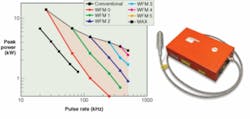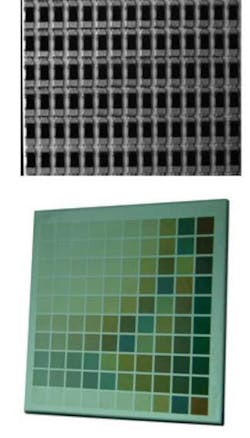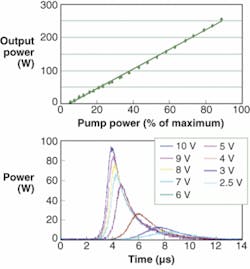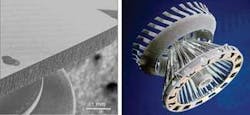STEVE NORMAN AND MIKHAIL ZERVAS
As fiber lasers extend their performance capabilities and penetrate markets that were previously the strongholds of conventional laser technologies, the question now is: what are the limits of fiber-laser applications? Whether the application is in the lower-power marking or microelectronics sectors or in the high-power machining and materials-processing sector, the impressive growth of fiber lasers is driven by end-use application benefits derived from their ease-of-use, precision, stability, and operational flexibility.
Peak-power scaling in pulsed lasers
The laser-marking sector typically requires compactness, low cost, ease of integration, and robustness. Applications demand performance capabilities that enable materials as diverse as metals, polymers, and even organic materials such as food to be precisely and repeatedly marked. This type of processing requires a pulsed laser output that maintains high peak power over an extended range of pulse energies and repetition rates.
Today, “single-solution” pulsed fiber-laser modules offer an excellent combination of beam quality (M2 less than 2) and controllable pulse repetition rate, peak power, and pulse energy (see Fig. 1). In an all-fiber integrated laser from SPI Lasers, pulse-shaping technology called “PulseTune” is combined with an architectural design using a master-oscillator power amplifier (MOPA) for high-gain pulse amplification. The module’s average output power of 20 W can be utilized across a broad parametric window, from high-energy pulses of 0.8 mJ per pulse at 25 kHz repetition rate (for marking hard metals), to low-energy, high-speed pulses of 40 µJ per pulse at up to a state-of-the-art repetition rate of 500 kHz (for high-speed marking onto polymer substrates, for example). The corresponding peak powers are typically 15 to 20 kW at the high-energy end and more than 1 kW at the high-speed end. The laser can be operated in continuous-wave (CW) mode and power-modulated for bitmap marking applications. The output wavelength is in the 1 µm range.
FIGURE 1. Pulse-shaping technology and a master-oscillator power-amplifier (MOPA) configuration enable peak powers in excess of 3 kW for repetition rates up to 500 kHz (left) in a fiber laser from SPI Laser (right). The mutually dependent seed-pulse shapes and repetition rates of conventional laser sources can provide comparable performance only up to 40 kHz. (Courtesy of SPI Lasers)
This pulsed performance with sustained high peak power over a broad range of repetition rates cannot be matched by Q-switched lasers (of equivalent power and size), whether diode-pumped solid-state (DPSS), or fiber-based. With the Q-switched laser design, increasing the pulse repetition above a certain rate progressively leads to pulse collapse and pulse widths increase substantially as peak powers fall off dramatically.
The key innovation with the PulseTune MOPA approach is a decoupling of the pulse control (shape and repetition rate) from the amplification stage, allowing pulse width and peak power to be programmed independently of the repetition rate. PulseTune technology can enable peak powers in excess of 3 kW for repetition rates up to 500 kHz. Conventional technologies are inflexible with mutually dependent seed-pulse shapes and repetition rates that provide comparable performance only up to 40 kHz. Such performance differences can result in a tenfold increase of process throughput.
With its high parametric control and flexibility, SPI’s redEnergy pulsed laser is finding widespread use beyond basic marking applications, in a number of demanding higher-added-value applications such as color marking on stainless steel, liquid-crystal-display (LCD) trimming, and microelectronics (memory repair) where high-throughput processing with precise and repeatable control of pulse energy is essential (see Fig. 2).
FIGURE 2. Pulsed fiber lasers can be applied to color-marking applications, such as a color palette on stainless steel achieved through pulse-energy and repetition-rate control (top). In another application, resistor trimming is performed using a 15 W pulsed fiber laser operating at 250 kHz (bottom). (Top courtesy of SPI Lasers; bottom courtesy of Ilios)
Power scaling of CW lasers
The robust, all-fiber, all-guided architecture of fiber lasers offers instant turn-on operation without the need for regular tuning and realignment. The inherently large surface-to-volume ratio of the active-fiber cavity facilitates heat removal and minimizes external cooling requirements. By using very-low-loss, monolithic all-fiber architectures, outstanding optical-to-optical, electrical-to-optical, and relatively high overall wall-plug efficiencies can be achieved. Beam quality can be engineered by proper fiber core design and the absence of thermal lensing effects in the fiber waveguide structure results in excellent beam quality and pointing stability that are invariant with power.
Because fiber lasers are usually pumped by combining a number of extremely robust telecommunication-grade, single-emitter broad-stripe multimode pump diodes, they have the potential to be rapidly modulated at rates up to 100 kHz and beyond.
All of these attributes make fiber lasers ideally suited for scaling to higher powers for CW or quasi-CW operation for microelectronics applications in which beam quality, precision, and stability are critical. In many applications, the ability to control and vary the laser processing energy and power input can be the process enabler. For example, in the microcutting of thin metal sheets and tubes (such as printed-circuit-board stencils and arterial stents, respectively), the use of laser power modulation is a major contributor to the process, reducing thermal effects such as the heat-affected zone (HAZ), reducing dross (inherent debris on the cut), and permitting kerf widths of less than 20 µm.
With its patented GTWave technology, SPI’s 200 W single-mode OEM laser system has an excellent optical input/output response (see Fig. 3). The operating wavelength is in the 1 µm region, the output is single-mode, and the system’s optical-to-optical conversion efficiency is better than 50%. At maximum output power the root-mean-squared noise is less than 1%, enabling industrial applications with precise control and extreme repeatability. This class of lasers (and its corresponding 100 W and 150 W counterparts) can be deployed for ultrafine cutting applications, fine engraving in the printing industry, metal-powder sintering (rapid prototyping), and for general-purpose cutting and welding. The architectural design, electronics, and control algorithms have been designed to provide both CW and modulated (CW-M) mode of operation.
Active fibers are inherently high-gain, low-background-loss media requiring relatively low-Q cavities for optimum performance. The combination of low-Q cavities and large intracore signal intensities results in rapid laser-cavity depletion, which can substantially increase the frequency of CW-M operation up to 100 kHz.
Enabling technology
In addition to enhancing and even replacing existing solutions in a diverse number of demanding industrial and medical applications, novel and important new applications for these lasers are emerging as applications specialists investigate the performance features and flexibility of the all-fiber solution (see Fig. 4).
FIGURE 4. Fiber lasers are enabling new applications, including the machining of silicon wafers with negligible edge cracking compared to conventional laser processes (left). A 200 W fiber laser can also be used for fabricating sintered-metal rapid-prototyped parts such as this flexible mirror mount for a laser application, manufactured by sintering Titanium 2 powder (right). (Left courtesy of SPI Lasers; right courtesy of Innoshape and BESSY)
The adoption of a pumping scheme is key to harnessing the benefits of an all-fiber laser configuration and scaling it to higher power levels. Even a few percent coupling loss occurring in a splice, taper, or pump-injection coupler can lead to several watts of heat dissipation in a localized region. Single-point injection techniques, such as end-pumping or V-groove side-pumping can result in “hot spots” and premature product failure. In contrast, a patented solution from SPI uses multiport, multipoint pump injection by utilizing a composite fiber (GTWave) containing an active fiber and a pump fiber surrounded by a common coating. Pump radiation launched into the pump fiber couples into the active fiber gradually-in a distributed manner-over its entire length, avoiding hot spots and facilitating output-power scalability. Also, the use of nonphotodarkening fiber ensures stability and high efficiency over the product lifetime.
In addition to multiple pump injection ports, which can be increased by including additional pump fibers, the GTWave signal-fiber ends remain free for further splicing, enabling the cascading of several units without obstructing the signal optical path. Recently, SPI has demonstrated GTWave fiber-laser units with output power in excess of 450 W, a power level that will further increase the penetration of fiber lasers into the industrial application arena.
Ultimate potential
Single-fiber, single-mode-output fiber lasers with power levels in excess of 1 kW have been reported. Furthermore, simple considerations of the expected thermal load and fiber optical-damage threshold suggest that this output can be extended to 10 kW, suitable for higher-power industrial and aerospace applications. Several groups are currently working on power combination and power scaling to multikilowatt single-fiber levels. This level, however, will require the development of brighter pumps and special active fibers to enable precise modal control and suppress optical nonlinearities.
Fiber lasers can also provide an extended range of optical wavelengths by using either different active dopants (including erbium, erbium-ytterbium, neodymium, and thulium) or by exploiting optical nonlinearities (such as Raman gain).
Fiber lasers are proving to be a versatile and robust technology offering outstanding performance, scalable output power, and extended wavelength coverage. They have enhanced existing applications and are enabling new ones in the industrial sector-progressively increasing their market share.
Tell us what you think about this article. Send an e-mail to [email protected].
STEVE NORMAN is chief technology officer and MIKHAIL ZERVAS is chief scientist at SPI Lasers, 3 Wellington Park, Tollbar Way, Hedge End, Southampton SO30 2QU, England; e-mail: [email protected]; www.spilasers.com. MIKHAIL ZERVAS is also with the Optoelectronics Research Centre at the University of Southampton in Southampton, England.



